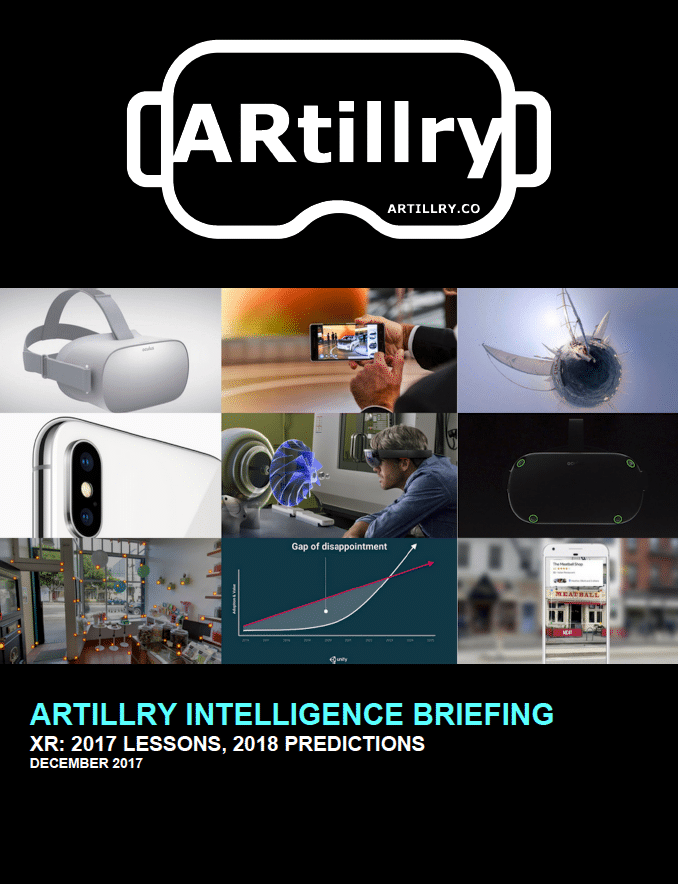
This post is continues from last week’s examination of AR business models. It picks up where that post ended, and goes deeper into app UX strategies. It’s also adapted from ARtillry’s latest Intelligence briefing, XR: 2017 Lessons, 2018 Predictions. Preview more of the report here, or subscribe to access it in full.
 For success in the revenue models examined last week, compelling mobile AR user experiences first have to be developed. And one of the biggest guiding principles to achieve that is native thinking. Build new experiences around AR capability, rather than tacking AR on to existing apps.
For success in the revenue models examined last week, compelling mobile AR user experiences first have to be developed. And one of the biggest guiding principles to achieve that is native thinking. Build new experiences around AR capability, rather than tacking AR on to existing apps.
Also known as “AR-first,” we learned the same lesson in “mobile first” app design strategies of the last decade. Extending that logic, “AR-only” thinking also holds potential. This involves AR experiences that can’t exist outside of AR: Augmentation is critical to an app, not just additive.
Furniture or car visualization apps are good examples of AR-only thinking: Though it’s a narrow use case, they solve pain points — personalizing large items — and are only possible in AR. Non-AR only thinking is conversely seen in games whose AR mode is only slightly additive to the UX.
At AR’s early stages there will be a lot of this “add-on” functionality. But we’ll eventually get to true AR value when the first breakout AR-only app catches fire. It was that same thinking that brought us apps like Uber, which at the time of inception was “mobile-only”… it wouldn’t work on PCs.
When thinking in this native mindset, remember that AR is a snack, not a meal. We’ve learned so far that mobile AR app experiences built around short bursts of AR activity resonate more than those that require users to walk around with outstretched arms (not to mention battery drain).
When it comes to practical realities like this, part of the challenge is a classic “Silicon Valley effect.” Being immersed in a tech culture, it’s hard to detach and put ourselves in the shoes of mainstream consumers. But the goal is to solve human pain points, not engineering feats.
“What are other problems where AR finally helps bridge the gap?” Samsung Next’s Jacob Lowenstein posed recently at AWE Europe. “Work backwards from there. Because if you’re going technology-first you’re going to end up walking into a door.”
Repeat Performance
Beyond native thinking it’s important to be mindful of novel thinking, and to not rely too greatly on it. There are lots of low-value AR apps already populating Apple’s app store, which have value that resides only in novelty. The problem is that novelty wears off quickly and those apps languish.
This can be avoided in a few ways, many of which inherit best practices from the last decade in app development. For example, game mechanics that balance challenging play with attainable goals perform well. Achievement-based rewards and social sharing can also cause stickiness.
Speaking of social, collaboration is another important factor. Synchronous AR between friends (see the same graphics on different devices) requires a robust AR cloud though. And though Apple is improving ARkit in lots of way, multiplayer support has reportedly been back burnered.
Meanwhile tools that engender ongoing utility can add stickiness, such as anything grounded in a frequent activity like communications. Combining some of the above factors, AR apps that infuse or add value to communications and social interaction can have greater active use.
One example of that combination is Snaappy. It develops AR animated characters that add dimension and meaning to social messaging. This not only carries the above traits but it does so on top of an increasingly-popular and frequently-used interface for millennials: messaging.
“Communication is good when it comes to retention but bad when it comes to wow effect and engagement,” Snaappy CEO Gal Shvebish told ARtillry. “On the other hand, AR is great for wow effect and engagement, but bad for retention. If you combine the two into one system, you can take advantage of both [and] really create something that will be here for the long run.”
Additional depth is provided in the full report. Preview or subscribe to access it in full.
For a deeper dive on AR & VR insights, see ARtillry’s new intelligence subscription, and sign up for the free ARtillry Weekly newsletter.
Disclosure: ARtillry has no financial stake in the companies mentioned in this post, nor received payment for its production. Disclosure and ethics policy can be seen here.

